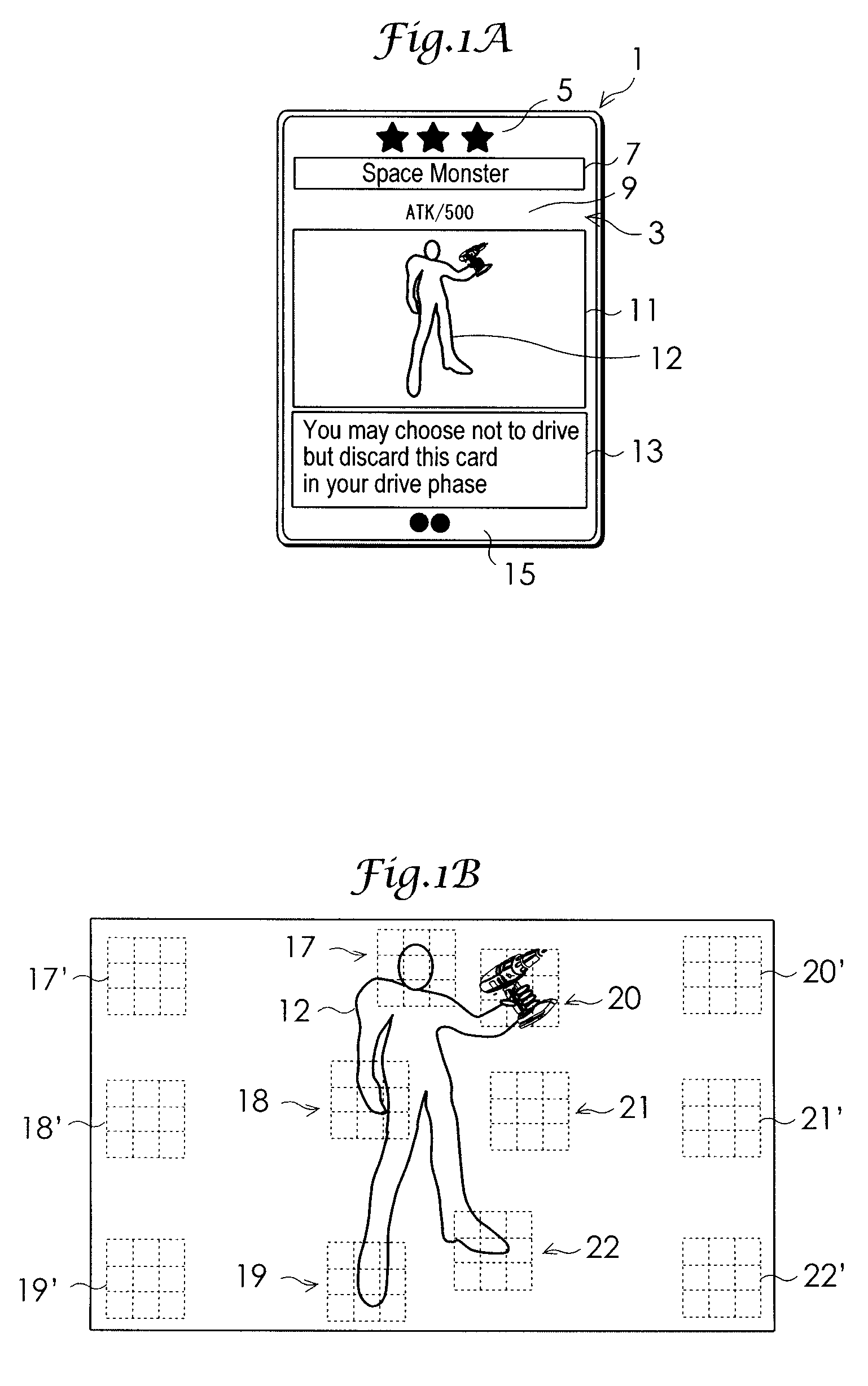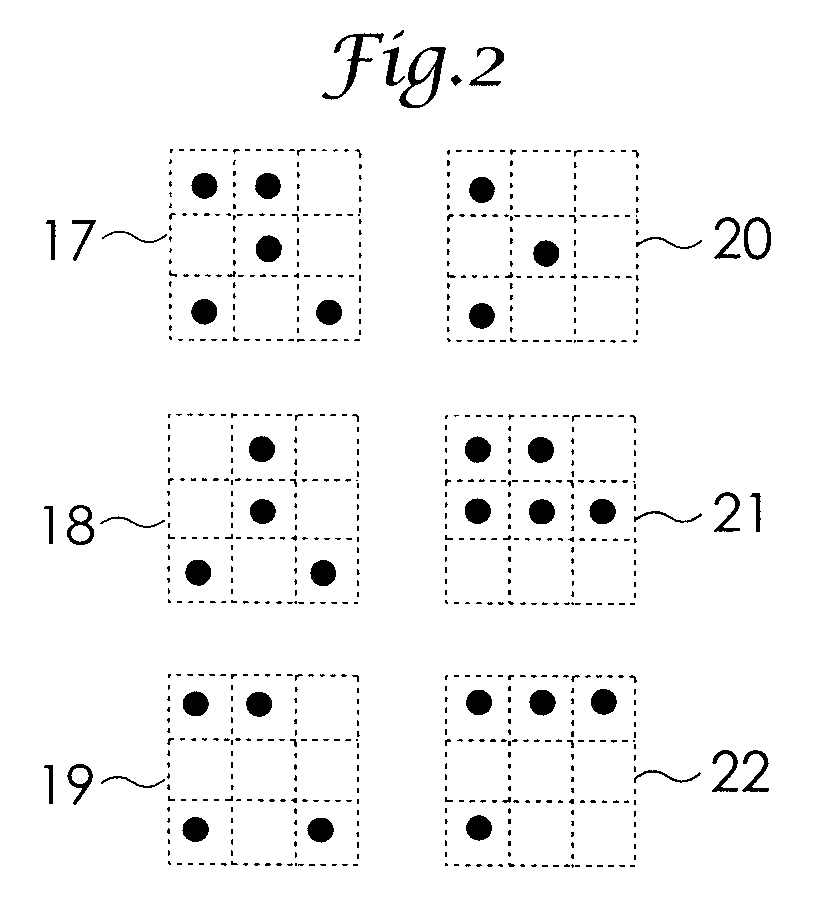[0005]An object of the present invention is to provide a game card and a card game for two or more players, wherein the positional arrangement or positions at which a plurality of visually unrecognizable identifying indications or information are disposed are defined in relation to the positional arrangement or positions at which a plurality of visually recognizable informational indications or information are disposed so that the player can joyfully work out a strategy.
[0006]Another object of the present invention is to provide a less costly game card which does not hinder the player in visually recognizing the visually recognizable informational indications or information indicated thereon and of which the aesthetic appearance is not damaged if a plurality of identifying indications are disposed on a front face of the card generally having available space limited for printing.
[0008]According to the present invention, a game card comprises a plurality of visually recognizable informational indications which are disposed on a front face thereof. The plurality of visually recognizable informational indications are expressed in letters, symbols, figures, pictures, images, or the like. The game card also comprises a plurality of identifying indications to be utilized in the course of a game. The identifying indications are provided on the card by using a visually unrecognizable but optically, magnetically, or electronically recognizable material. The optically recognizable material typically includes a material containing a light emitting element which emits light when irradiated with
infrared rays, a transparent resin material, or the like. The shape formed on the card by a transparent special resin material can optically be recognized by selecting an appropriate frequency for rays of light to be irradiated on to the card. The optically recognizable material may arbitrarily be disposed on a front face of the card. When the optically recognizable material is printed by a printing technique on the front face of the card where the visually recognizable informational indications are disposed, the identifying indications may be displayed on the front face of the card in a simple and less costly manner. Thus, a special game card having identifying indications can be manufactured at low cost. Additionally, since an optically unrecognizable material is used to form identifying indications, the visually recognizable informational indications are not hindered in being visually recognized. Thus, the aesthetic appearance of the card is not damaged.
[0011]According to the present invention, the positional arrangement or positions at which the plurality of identifying indications are disposed are defined in relation to the positional arrangement or positions at which the plurality of visually recognizable informational indications are disposed. The term of “positional arrangement in relation to” means that the positional arrangement of the visually recognizable informational indications has some relationship with the positional arrangement of the identifying indications disposed so as to associate with the visually recognizable informational indications. More specifically, at least one of identifying indications is disposed adjacent to, on or under the visually recognizable informational indications. For example, when the plurality of visually recognizable informational indications are expressed in a combination of figures or pictures, the plurality of identifying indications are disposed near, on or under the plurality of figures or pictures. When the identifying indications can optically be read, the identifying indications may be disposed near or on the plurality of figures or pictures. In short, the identifying indications are disposed in such a manner that “the positional arrangement of the identifying indications are in relation to” positions at which the visually recognizable informational indications are disposed. When the plurality of identifying indications are disposed along an edge of the card to correspond to positions at which the plurality of visually recognizable informational indications are disposed, “the positional arrangement is in relation to” positions at which the visually recognizable informational indications are disposed. Since the positional arrangement of visually unrecognizable identifying indications is defined in relation to the positional arrangement of visually recognizable informational indications, the player can joyfully conjecture the identifying indications by referring to the positional arrangement of the visually recognizable informational indications.
[0012]A game card according to the present invention may be used for a card game for two or more players that comprises a
deck of cards with a plurality of visually recognizable informational indications disposed on a front face thereof, and a play field where at least one of the cards is placed in the course of the game. Here, a reader is used which optically, magnetically, or electronically recognizes the identifying indications and displays a recognition result in the form to be visually and / or audibly recognized. The reader is configured to selectively read one of the identifying indications by a single reading operation. When a plurality of identifying indications are displayed on the card, at least one identifying indication can be selected from the plurality of identifying indications by using the reader. Consequently, the result may be varied according to how to select identifying indications, thereby allowing unexpected developments in the game. Preferably, when the reader is operated for a reading operation in the course of the game and selectively reads at least one of the identifying indications, the reader may display the recognition result based on the at least one identifying indication which has been read. More preferably, the reader may be configured to output the recognition result which varies according to a combination of the identifying indications which are read or an order in which the identifying indications are read. With this configuration, an unexpected result may be obtained based on the combination of the identifying indications, thereby allowing the player to always enjoy new and fresh developments even if the player is accustomed to the game.
[0013]In the game card of the present invention, since positions at which a plurality of identifying indications are disposed are defined in relation to positions at which a plurality of visually recognizable informational indications are disposed, the player searches for the identifying indications by using the reader, conjecturing where the plurality of invisible identifying indications are disposed with reference to positions at which the plurality of the visible and visually recognizable informational indications are disposed. Thus, the player cannot immediately determine what result can be obtained by selecting identifying indications, although the card belongs to the player. Accordingly, the game can develop in an unexpected way and the player can enjoy a thrilling game. Additionally, since a plurality of invisible identifying indications are provided on the card, the player cannot predict what identifying indications the opponent player will select even if it is known that a plurality of identifying indications are hidden in the card. Thus, the player can enjoy a thrilling game.
 Login to View More
Login to View More  Login to View More
Login to View More 


